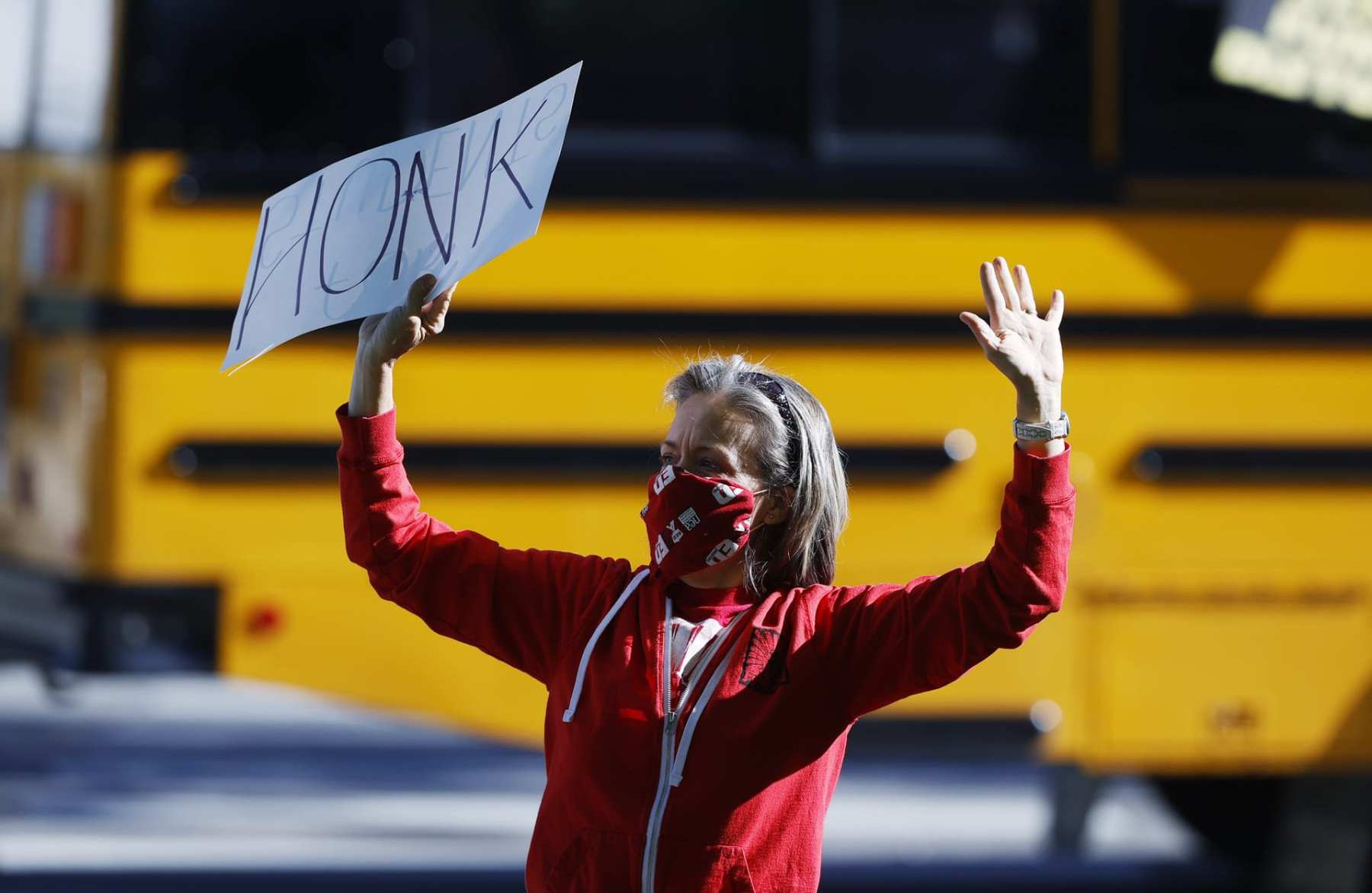Women continue to weather the worst of this coronavirus-induced economic storm, but out in the horizon, another disturbance is forming.
Public sector jobs are expected to take a greater hit as plummeting tax revenues across the country slash local and state government budgets, setting off layoffs and furloughs. When the job losses come, it’ll be women who will be most at risk.
Nearly 60 percent of public sector employees are women, many of them women of color — the same demographic groups that already experienced the highest rates of unemployment when COVID-19 ripped through the job market. (Unemployment for Latinas peaked at 20.2 percent this year, and unemployment for Black women hit 16.5 percent). The one-two punch of the depletion of child care options and the closure of service sector businesses, jobs dominated by women, set off the nation’s first female recession. About 54 percent of all the jobs lost since the pandemic began were held by women.
But with more cuts likely to come, now the question is: How bad could it get?
“We are already seeing it,” said Heidi Shierholz, senior economist and director of policy at the Economic Policy Institute (EPI). “But it’s just gonna get way, way worse.”
Already, 1.4 million local and state government jobs were lost between February and June, almost two-thirds of them jobs that employed women. Furloughs have already started at universities and in city and county governments.
But like in past recessions, the steepest cuts typically come later. With the Great Recession, job loss in the United States began in 2008 and cratered in 2010. But the losses for the public sector didn’t register until three years later. In 2013, public sector jobs hit their lowest point since 2001, when the Bureau of Labor Statistics started tracking the figures.
The delay is informed by the crumbling of the tax base and the impact that has on government budgets in the years after a recession first hits. In an August report, the National League of Cities estimated that cities would see a year-over-year decline of 11 percent in sales tax receipts in their fiscal year 2020 budgets. The hit to property taxes is starting to crop up, too, with growth from 2019 to 2020 expected to be at just 1.9 percent. Both are key funding sources for public sector jobs.
This year, the first coronavirus stimulus bill, the CARES Act, has kept some of the losses at bay, allocating $150 billion to state and local governments to cover mostly coronavirus-related costs. An additional $600 weekly unemployment insurance payment helped families keep up with their rents and mortgages. The Paycheck Protection Program loan kept some businesses open and workers on their payrolls, helping those businesses continue to pay taxes and allowing workers to continue buying goods and services. Eviction moratoriums kept folks from falling over a financial precipice, allowing them to continue making other payments and buying necessities.
But the $600 weekly payments and the moratoriums have ended. EPI found that if the federal government doesn’t do anything to address budget shortfalls estimated to hit nearly $1 trillion by the end of 2021, some 5.3 million jobs — many of them public — could disappear.
And it’ll hurt not just those workers, but people who rely on social services — like unemployment — emergency responders and sanitation workers.
“We’re going to start seeing stuff in September. People are going to start getting evicted in September. People are going to start relying on services like homelessness services, things like that,” said economist Olugbenga Ajilore with the Center for American Progress, a left-leaning think tank.
And because those services will be harder to receive due to there being fewer workers, “we’ll see this cascading effect,” Ajilore said.
A missed stepping stone
For many workers in the public sector, these jobs are viewed as a pathway to the middle class.
“The public service, that’s been an avenue for women, specifically women of color, to have good wages and good benefits and to provide essential services to the communities in which they live. They are in jeopardy right now,” said Lee Saunders, president of the American Federation of State, County and Municipal Employees union.
The uncertainty is worrying Josette Jaramillo, a lead case worker in the foster care unit in Pueblo County, Colorado. During the Great Recession, she was furloughed and lost her house and her car. She filed for bankruptcy in 2008.
So far, layoffs haven’t started yet, she said, but administrative dollars have already been cut.
“If things dip a little lower and property taxes dip a little lower, I think that’s a real possibility for us,” Jaramillo said.
Workers in her region are looking with concern at nearby Denver County, where furloughs and layoffs have begun. If a major county like that can’t keep it’s employees, how will theirs? It’s the question most asked by her coworkers: “Have you heard about layoffs? Have you heard about furloughs?”
“We think people right now are on the balls of their feet wondering if this is going to be something that affects us,” Jaramillo said.
In Gatesville, Texas, home to half a dozen female state prisons, corrections officer and union president Tanisha Woods is hoping her job remains in its essential capacity, helping her escape any upcoming cuts.
But when she looks around her, at a region dominated by public services that support the prisons, she worries about her union membership. (The public sector has higher-than-average union participation, with about 35 percent of workers under a contract compared to about 7 percent of private workers.)
“It’s a small town, a small community, and really I think it’s the prisons that really drive the business,” she said. “I haven’t heard anything about cuts. I don’t think it starts getting real until we actually see it happen.”
A legislative stopgap
The decisions Congress makes in the coming months will shape how deep the cuts could be later.
“If Congress comes and steps in and fills in budget shortfalls, there don’t have to be any state and local job losses,” said EPI’s Shierholz. “It’s like a complete unforced error on the part of the federal government.”
But the House and the Senate have been in a deadlock for weeks about what to do in the next round of relief. The issue of how much to give cities and states is one of the points of contention.
Democrats have pushed for nearly $1 trillion in additional state and local aid through the HEROES Act, while Republicans say the figure should stay at the $150 billion allotted in the initial CARES Act, but with some added flexibility on how state and local governments can use the money to cover gaps in fiscal years 2020 and 2021. (Earlier in the year, the funds were only to be used to cover coronavirus-related expenses incurred beginning in March.)
President Donald Trump signed an executive order in August to give $300 in weekly payments of federal unemployment insurance to laid-off or furloughed workers — half the previous amount — while states are expected to chip in an extra $100. So far, few checks have gone out.
The issue of public service aid has some bipartisan support. In early August, New York’s Democratic Gov. Andrew Cuomo and Arkansas’ Republican Gov. Asa Hutchinson — the chair and vice chair, respectively, of the National Governors Association — issued a joint letter calling for $500 billion in aid to states.
“NGA continues to urge Congress and the White House to reach a quick resolution to provide immediate assistance to unemployed Americans. This resolution should avoid new administrative and fiscal burdens on states,” they wrote.
Republican Sen. Bill Cassidy has been a vocal supporter of additional aid to state and local governments, signing onto a bipartisan bill that would offer the $500 billion the NGA is looking for. But other GOP leaders are torn on the subject, saying some of the proposals are too costly and noting that some of the budget shortfalls predate coronavirus.
If the two sides can’t decide, “a lot of people are going to get hurt,” said Saunders of the public service workers’ union. “A lot of people are gonna be unemployed. A lot of people are going to rely upon services that are going to be reduced because of the fact that there’s no money available.”
Saunders, who has been with the union for 42 years, said this moment is an inflection point unlike any he’s experienced in his career.
“This country is facing a challenge we’ve never faced before,” he said. “The question is how we adapt.”





